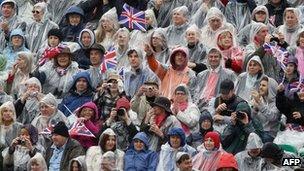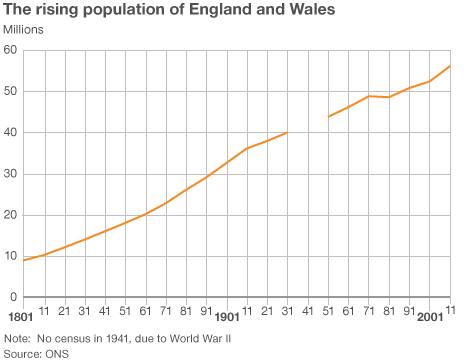England and Wales population up
- Published
- comments

The population has grown by 7% in a decade, the Census showed
The population of England and Wales has reached 56.1 million, up by 3.7 million in a decade, the 2011 Census shows.
It is the largest growth shown by any census since they began in 1801.
The population in England was 53 million on 27 March 2011 when the census was taken, about 400,000 more than official estimates.
In Wales the population was 3.1 million. Around 55% of the 3.7m increase was attributed to net migration.
The census showed that the population for England and Wales was greater than official estimates rolled forward from 2001 - by just over 500,000.
Data shows that from March 2001 to March 2011, there were 6.6 million births and five million deaths in England and Wales, leading to an increase in the population of 1.6 million.
The Office for National Statistics said this accounted for around 44% of the total increase in population size, with the remainder being due to migration.
BBC home editor Mark Easton says the most likely reason for the discrepancy between the official estimate and the actual population is inaccurate migration data.
It is notable that the number of people in their 20s has risen from 6.6m to 7.6m - that additional one million people are most likely to be migrant workers, he adds.
The latest rise compares with a rise in population of 1.6 million between 1991 and 2001.
The population projections published by the ONS will be revised upwards in the autumn.
On the night of the census there were 23.4 million households in England and Wales, with the average household size being 2.4 people per household in 2011, just over half of the 4.3 residents per household 100 years earlier.
The 2011 Census also showed the average population density was 371 people per square kilometre; however, in London this figure was 5,200.
If the London figures were excluded, the average population density for the rest of England and Wales was 321 people per square kilometre, the ONS said.
All regions saw population growth between 2001 and 2011, with the highest growth in London, the East of England and the East Midlands.
Other population data showed:
there were almost a million more women than men in England and Wales - 27.6 million men v 28.5 million women
the median age of the population - where half the population is younger and half is older - in England and Wales was 39, with the median age for men being 38 and for women 40
there were 406,000 more under-five-year-olds than in 2001
one in six people in England and Wales in 2011 was aged 65 and over
the percentage of the population aged 65 and over was the highest seen in any census - at 16.4%
there were 430,000 residents aged 90 and over in 2011 compared with 340,000 in 2001 and 13,000 in 1911
<link> <caption>Cardiff saw the greatest population rise of anywhere in Wales</caption> <url href="http://www.bbc.co.uk/news/uk-wales-18855679" platform="highweb"/> </link> , growing by 12%
The public were asked questions about their jobs, health, education and ethnic background. It was the first time people could fill in the form online.
The form was compulsory, but a question about religion was optional. The answers are used to plan public services.
Three different censuses happened on the one day. Northern Ireland and Scotland each managed their own, and these were run separately from the one which was sent to 25.4 million households in England and Wales.
Northern Ireland's population rose to 1.81 million - the highest figure ever - according to its census.
Glen Watson: These figures are really significant
The number of people increased by 7% over the last decade, broadly in line with the figure for England and Wales.
The just-published figures showed an increase in the proportion of elderly people and a decrease in the percentage of children under 16.
Figures for Scotland will be released later this year.
